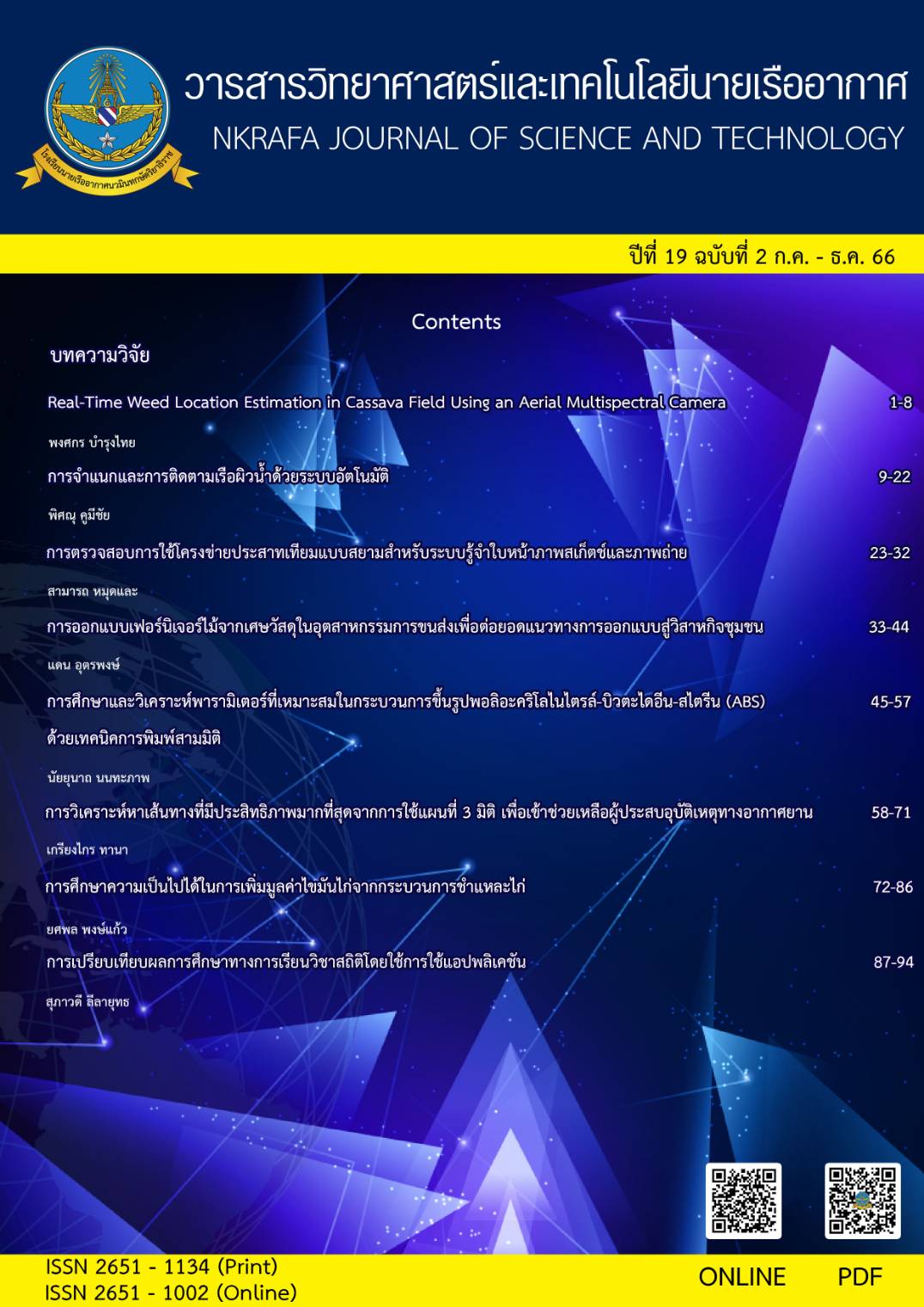Investigation and Optimization of Printing Parameters of 3D-Printed ABS-Based parts
Main Article Content
Abstract
Recently, 3D printers have rapidly expanded and played an important role in the fabrication of composite materials because they are able to design complex and durable aerospace component structures. The objective of this research is to study the effects of printing or processing parameters on 3D printers and find the most appropriate values that provide the best properties for three-dimensional modeling. In this work, the ABS filament was used as a precursor for the 3D printing process, and a study on the effect of nozzle temperature (240°C, 250°C, and 260°C) and infill density (25%, 50%, 75%, and 100%) on morphology, crystallinity index, mechanical properties, and thermal properties was performed. The 3D-printed parts were then characterized using scanning electron microscopes (SEM), universal testing machines (UTM), X-ray diffraction analyzers (XRD), thermal mechanical analyzers (DMA), and thermogravimetric analyzers (TGA). The experimental results showed that at higher nozzle temperatures, the adhesion between the layers improved and the air voids were smaller. These led to an increment in the crystallinity index. In addition, the higher printing temperature can enhance the storage modulus, which makes the part harder to dislocate. The results also indicated that the tensile strength of 3D-printed parts increased with increasing infill density. Nevertheless, these two parameters had no effect on thermal stability since the decomposition temperature did not change even when the processing condition was adjusted.
Article Details

This work is licensed under a Creative Commons Attribution-NonCommercial-NoDerivatives 4.0 International License.
- Content and information in articles published in NKRAFA Journal of Science and Technology are comment and responsibility of authors of articles directly. Journal editorial do no need to agree or share any responsibility.
- NKRAFA Journal of Science and Technology Articles holds the copyright of the content, pictures, images etc. which published in it. If any person or agency require to reuse all or some part of articles, the permission must be obtained from the NKRAFA Journal of Science and Technology.
References
Choudhari, C.J., Thakare, P.S. and Sahu, S.K., 2021. 3D printing of composite sandwich structures for aerospace applications. In High-performance composite structures: additive manufacturing and processing (pp. 45-73). Singapore: Springer Singapore.
Shahrubudin, N., Lee, T.C. and Ramlan, R.J.P.M., 2019. An overview on 3D printing technology: Technological, materials, and applications. Procedia Manufacturing, 35, pp.1286-1296.
Tofail, S.A., Koumoulos, E.P., Bandyopadhyay, A., Bose, S., O’Donoghue, L. and Charitidis, C., 2018. Additive manufacturing: scientific and technological challenges, market uptake and opportunities. Materials today, 21(1), pp.22-37.
Fernandes, J., Deus, A.M., Reis, L., Vaz, M.F. and Leite, M., 2018, May. Study of the influence of 3D printing parameters on the mechanical properties of PLA. In Proc. Int. Conf. Prog. Addit. Manuf (Vol. 2018, pp. 547-552).
Wu, J., 2018, August. Study on optimization of 3D printing parameters. In IOP conference series: materials science and engineering (Vol. 392, p. 062050). IOP Publishing.
Fontana, L., Minetola, P., Iuliano, L., Rifuggiato, S., Khandpur, M.S. and Stiuso, V., 2022. An investigation of the influence of 3d printing parameters on the tensile strength of PLA material. Materials Today: Proceedings, 57, pp.657-663.
Coppola, B., Cappetti, N., Di Maio, L., Scarfato, P. and Incarnato, L., 2018. 3D printing of PLA/clay nanocomposites: Influence of printing temperature on printed samples properties. Materials, 11(10), p.1947.
Xu, X. and Gupta, N., 2018. Determining elastic modulus from dynamic mechanical analysis: a general model based on loss modulus data. Materialia, 4, pp.221-226.
Rajisha, K.R., Deepa, B., Pothan, L.A. and Thomas, S., 2011. Thermomechanical and spectroscopic characterization of natural fibre composites. Interface engineering of natural fibre composites for maximum performance, pp.241-274.
De Oliveira, G.C., Pereira, L.C., Silva, A.L., Semaan, F.S., Castilho, M. and Ponzio, E.A., 2018. Acrylonitrile-butadiene-styrene (ABS) composite electrode for the simultaneous determination of vitamins B 2 and B 6 in pharmaceutical samples. Journal of Solid State Electrochemistry, 22, pp.1607-1619.
Mulliken, A.D. and Boyce, M.C., 2006. Mechanics of the rate-dependent elastic–plastic deformation of glassy polymers from low to high strain rates. International journal of solids and structures, 43(5), pp.1331-1356.
Feiyang He and Muhammad Khan, Effects of Printing Parameters on the Fatigue Behaviour of 3D-Printed ABS under Dynamic Thermo-Mechanical Loads, 2021. Polymers, 13, p.2362.
Podsiadły, B.; Skalski, A.; Rozpiórski, W.; Słoma, M. Are We Able to Print Components as Strong as Injection Molded Comparing the Properties of 3D Printed and Injection Module Components Made from ABS Thermoplastic. Appl. Sci. 2021, 11, 6946. https://doi.org/ 10.3390/app1115694
Zin, M.H., Abdan, K. and Norizan, M.N., 2019. The effect of different fiber loading on flexural and thermal properties of banana/pineapple leaf (PALF)/glass hybrid composite. In Structural health monitoring of biocomposites, fibre-reinforced composites and hybrid composites (pp. 1-17). Woodhead Publishing.
Campbell, F.C., 2008. Crystalline Imperfections and Plastic Deformation. Elements of Metallurgy and Engineering Alloys, pp.17-39.
A. Zulfi, D.A. Hapidin, M.M. Munir, F. Iskandar, and K. Khairurrijal, 2019. The synthesis of nanofiber membranes from acrylonitrile butadiene styrene (ABS) waste using electrospinning for use as air filtration media. Rsc Adv., 9, p.30741.
Martineau, P.M., Gaukroger, M.P., Guy, K.B., Lawson, S.C., Twitchen, D.J., Friel, I., Hansen, J.O., Summerton, G.C., Addison, T.P.G. and Burns, R., 2009. High crystalline quality single crystal chemical vapour deposition diamond. Journal of Physics: Condensed Matter, 21(36), p.364205.
Parker, G., 2001. Encyclopedia of materials: science and technology.


